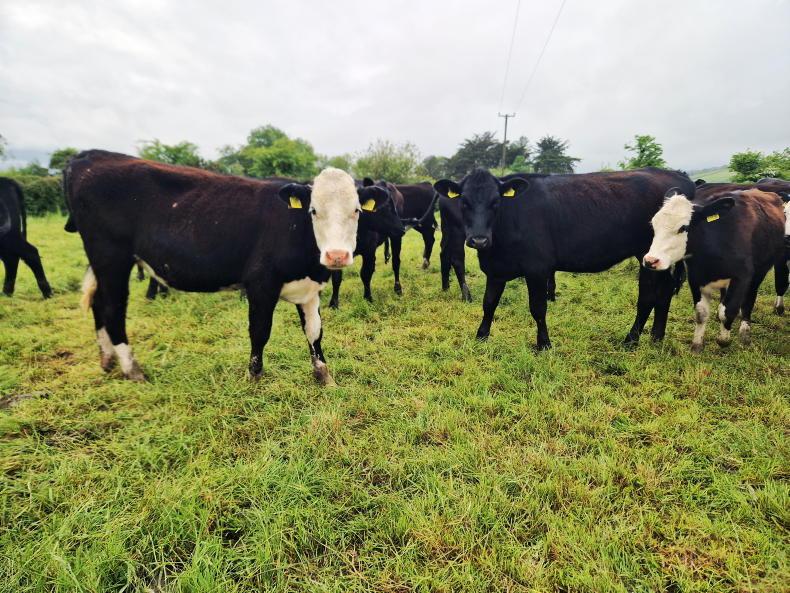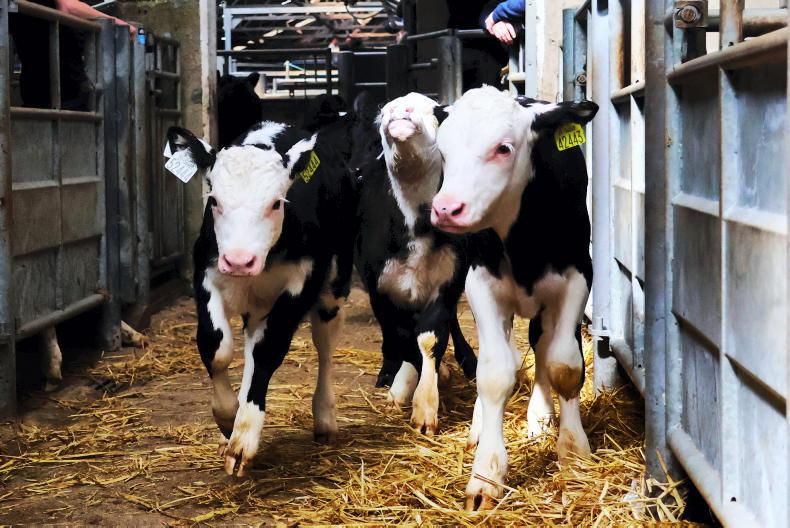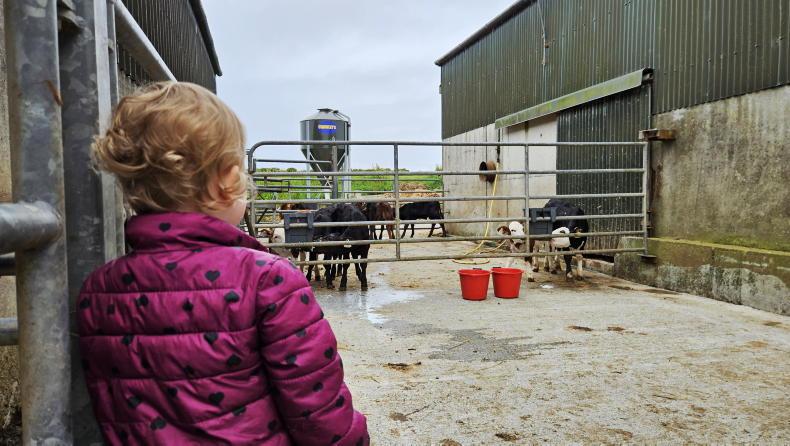John Brosnan farms with his wife, Fiona, and children, Ben and Clara, outside Castleisland in Co Kerry. The farm has been operating a dairy calf-to-beef system for the last number of years, with the family trying to improve the overall performance each year.
The home farm at Mullaghmarkey has a mixture of soil types, with some parts considerably heavy while most is quite dry. It is for this reason that the stocking rate on the farm has not been pushed, which allows greater flexibility in the shoulders of the year.
Dairy calf-to-beef systems suit the heavier ground, as cattle are lighter and do less poaching during difficult spells of weather.
Speaking of which, the last few weeks have been quite hard to manage on the farm, with heavy rainfall making conditions on some of the grazing ground quite poor.
When I visited late last week, there was a squelch underfoot after some heavy rain earlier in the week. In May, there had been over 70mm of rainfall, which was a similar level to April.
Despite this, grass growth over the last month has been very good. Being quite moderately stocked, this brings its own challenges however, and maintaining grazing quality will now need careful management over the coming weeks.
Farm system
Each year, the Brosnans rear 30 calves. In the past, this has been a mixture of Angus, Hereford and Belgian Blue, however, since last year, they have decided to concentrate on Angus and Hereford, as they felt the Belgian Blue-type heifers required a higher level of input or a later slaughter date.
Housing facilities are limiting on the farm, so at least some stock need to be either sold or slaughtered prior to the second winter period. Last autumn, the heaviest of the heifers were slaughtered off grass and some meal feeding with an average carcase weight of just over 250kg.
The final 13 heifers were then housed in early-November and fed silage and 3kg/day of a finishing ration. In early January, it was decided that the lightest seven heifers would be better stored over the winter and returned to pasture in spring for a partial grazing season and slaughtered off grass.

John Brosnan, Castleisland, Co Kerry.
The other five heifers, which were the heaviest, were fed on and drafted for slaughter in early February at an average carcase weight of 275kg.
On 8 March, the lighter heifers were turned out and remained at grass, receiving 3kg/day of a finishing ration until slaughter on 25 April. The batch averaged a carcase weight of 246kg and came into €1,207/head.
Commenting on this approach, John said: “It worked out well this year – beef price was in our favour this spring. In other years, I would have sold those few lighter heifers live in autumn and struggled to get €2/kg for them.
“Between silage, meal and a few weeks grazing in spring, they cost around €260/head to bring through the winter, but we added almost €450/head to their value so it was definitely worth it.”
Rising costs
The question now is if it will pay to do the same this year. Looking at the heifers grazing in late May, there will definitely be a draft from grass in autumn. After that, the question will be what to do with the ones which will not make the grade.
With higher silage and concentrate costs heading into winter, beef price will need to be strong next spring to make the task worthwhile. If the trade for store cattle in autumn is positive, which it could well be, especially for the Angus and Hereford on the farm, it may make more sense to sell live in autumn – only time will tell.
Weight gain at grass
The focus now it to put as many kilos of cheaper weight gain on the stock at grass as possible. Since turnout, the yearling heifers have gone quite dry and dull in the coat. This is likely a mineral issue.
Where they had been getting meal during the winter, it would have been delivering their daily requirements of vitamins and minerals. Often you can see cattle go dull in the coat on heavier ground types, where there may be a shortage or imbalance in the mineral profile in the grass diet.
John is now going to give the heifers a mineral bolus to cover for copper, selenium, iodine and cobalt. A bolus is longer acting than a drench and so one treatment should be sufficient for the season for these heifers.
If it is successful, it will be administered in spring prior to turnout in future years.
Calves
The calf rearing stage was relatively uncomplicated this year on the farm, with little to no health issues. There were three cases of bloat in the first few days after arrival, but it was quickly rectified and John feels it had to do with the concentration of the milk powder being too strong initially.
The strongest calves were weaned and turned out to grass in the second week of May, while the 10 lightest calves stayed on milk for another 10 days. Calves are eating 1kg/day of a calf ration at the moment, but John plans to move onto a 16% nut now that they are at grass.
Last year, some calves got cryptosporidium shortly after turnout, which may have been picked up from birds where they were eating meal from the trough. John is quite strict now in ensuring all meal offered is consumed straight away and that troughs are thoroughly cleaned before meal is offered in them.
“The calves that had crypto last year really melted in the space of a few days. I fed a probiotic which helped repair the lining of the gut and seemed to make a big difference, but you can still pick out the heifers that were worst affected by it yet,” John said.
John Brosnan farms with his wife, Fiona, and children, Ben and Clara, outside Castleisland in Co Kerry. The farm has been operating a dairy calf-to-beef system for the last number of years, with the family trying to improve the overall performance each year.
The home farm at Mullaghmarkey has a mixture of soil types, with some parts considerably heavy while most is quite dry. It is for this reason that the stocking rate on the farm has not been pushed, which allows greater flexibility in the shoulders of the year.
Dairy calf-to-beef systems suit the heavier ground, as cattle are lighter and do less poaching during difficult spells of weather.
Speaking of which, the last few weeks have been quite hard to manage on the farm, with heavy rainfall making conditions on some of the grazing ground quite poor.
When I visited late last week, there was a squelch underfoot after some heavy rain earlier in the week. In May, there had been over 70mm of rainfall, which was a similar level to April.
Despite this, grass growth over the last month has been very good. Being quite moderately stocked, this brings its own challenges however, and maintaining grazing quality will now need careful management over the coming weeks.
Farm system
Each year, the Brosnans rear 30 calves. In the past, this has been a mixture of Angus, Hereford and Belgian Blue, however, since last year, they have decided to concentrate on Angus and Hereford, as they felt the Belgian Blue-type heifers required a higher level of input or a later slaughter date.
Housing facilities are limiting on the farm, so at least some stock need to be either sold or slaughtered prior to the second winter period. Last autumn, the heaviest of the heifers were slaughtered off grass and some meal feeding with an average carcase weight of just over 250kg.
The final 13 heifers were then housed in early-November and fed silage and 3kg/day of a finishing ration. In early January, it was decided that the lightest seven heifers would be better stored over the winter and returned to pasture in spring for a partial grazing season and slaughtered off grass.

John Brosnan, Castleisland, Co Kerry.
The other five heifers, which were the heaviest, were fed on and drafted for slaughter in early February at an average carcase weight of 275kg.
On 8 March, the lighter heifers were turned out and remained at grass, receiving 3kg/day of a finishing ration until slaughter on 25 April. The batch averaged a carcase weight of 246kg and came into €1,207/head.
Commenting on this approach, John said: “It worked out well this year – beef price was in our favour this spring. In other years, I would have sold those few lighter heifers live in autumn and struggled to get €2/kg for them.
“Between silage, meal and a few weeks grazing in spring, they cost around €260/head to bring through the winter, but we added almost €450/head to their value so it was definitely worth it.”
Rising costs
The question now is if it will pay to do the same this year. Looking at the heifers grazing in late May, there will definitely be a draft from grass in autumn. After that, the question will be what to do with the ones which will not make the grade.
With higher silage and concentrate costs heading into winter, beef price will need to be strong next spring to make the task worthwhile. If the trade for store cattle in autumn is positive, which it could well be, especially for the Angus and Hereford on the farm, it may make more sense to sell live in autumn – only time will tell.
Weight gain at grass
The focus now it to put as many kilos of cheaper weight gain on the stock at grass as possible. Since turnout, the yearling heifers have gone quite dry and dull in the coat. This is likely a mineral issue.
Where they had been getting meal during the winter, it would have been delivering their daily requirements of vitamins and minerals. Often you can see cattle go dull in the coat on heavier ground types, where there may be a shortage or imbalance in the mineral profile in the grass diet.
John is now going to give the heifers a mineral bolus to cover for copper, selenium, iodine and cobalt. A bolus is longer acting than a drench and so one treatment should be sufficient for the season for these heifers.
If it is successful, it will be administered in spring prior to turnout in future years.
Calves
The calf rearing stage was relatively uncomplicated this year on the farm, with little to no health issues. There were three cases of bloat in the first few days after arrival, but it was quickly rectified and John feels it had to do with the concentration of the milk powder being too strong initially.
The strongest calves were weaned and turned out to grass in the second week of May, while the 10 lightest calves stayed on milk for another 10 days. Calves are eating 1kg/day of a calf ration at the moment, but John plans to move onto a 16% nut now that they are at grass.
Last year, some calves got cryptosporidium shortly after turnout, which may have been picked up from birds where they were eating meal from the trough. John is quite strict now in ensuring all meal offered is consumed straight away and that troughs are thoroughly cleaned before meal is offered in them.
“The calves that had crypto last year really melted in the space of a few days. I fed a probiotic which helped repair the lining of the gut and seemed to make a big difference, but you can still pick out the heifers that were worst affected by it yet,” John said.










SHARING OPTIONS